A Critique of Samsung's Organisational Design for Decision Making
VerifiedAdded on 2020/10/22
|13
|3847
|241
Report
AI Summary
This report presents a critique of Samsung's organizational design, focusing on its impact on decision-making processes within a complex environment. The analysis begins with an introduction to the crucial role of organizational design in supporting operational activities and achieving strategic goals. The main body delves into Samsung's transformation, from a manufacturer of electronic components to a global technological leader, highlighting the innovative measures and challenges faced. Key factors influencing Samsung's operational capabilities are examined, including goals, strategies, environmental factors, size and life cycle, organizational technologies, and culture. The report critiques Samsung's approach, identifying both advantages and potential drawbacks, such as the impact of managerial practices, stakeholder concerns, and technical shortcomings. The report concludes with a summary of the organizational design factors directly affecting Samsung's decision-making procedures and their effectiveness, offering insights into change management and strategic planning.
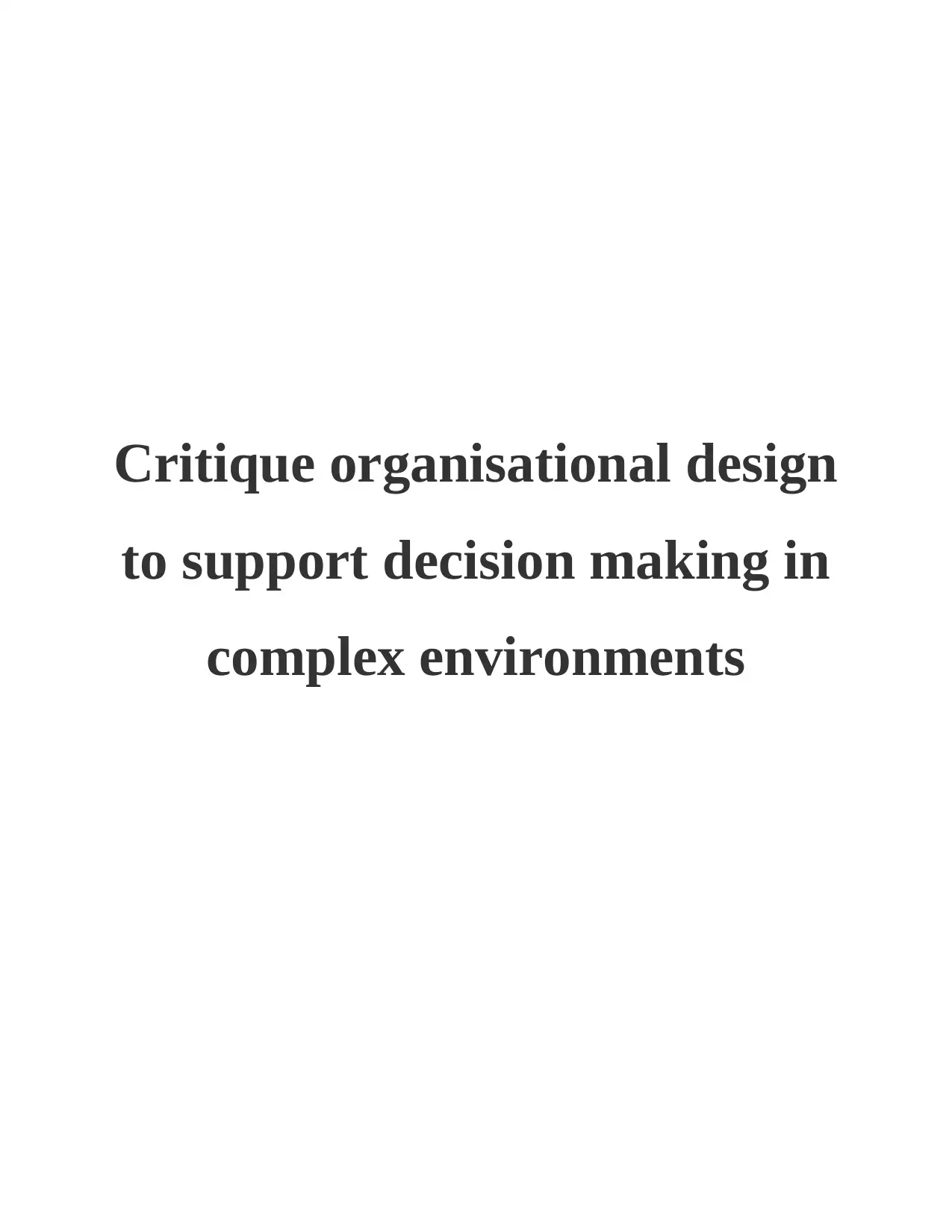
Critique organisational design
to support decision making in
complex environments
to support decision making in
complex environments
Secure Best Marks with AI Grader
Need help grading? Try our AI Grader for instant feedback on your assignments.
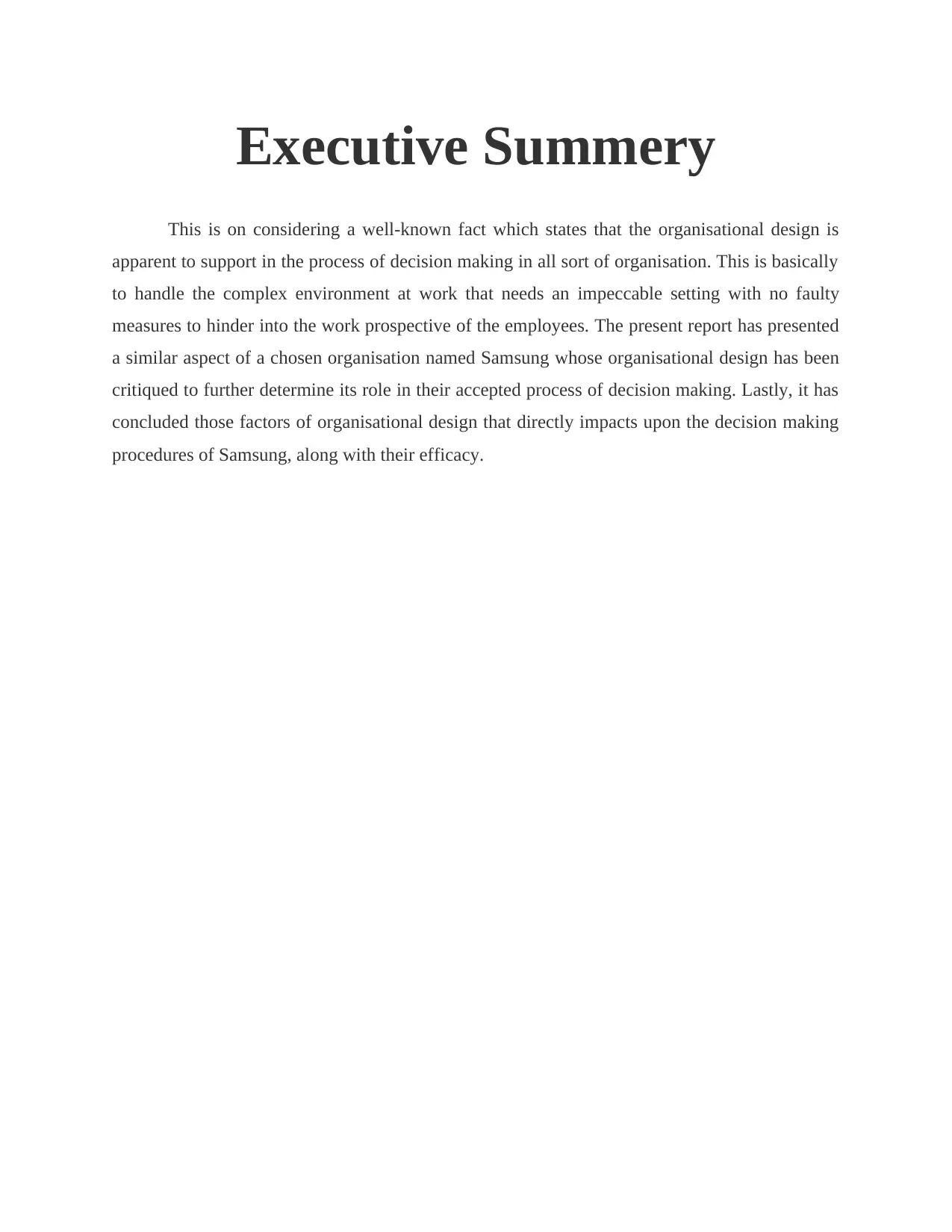
Executive Summery
This is on considering a well-known fact which states that the organisational design is
apparent to support in the process of decision making in all sort of organisation. This is basically
to handle the complex environment at work that needs an impeccable setting with no faulty
measures to hinder into the work prospective of the employees. The present report has presented
a similar aspect of a chosen organisation named Samsung whose organisational design has been
critiqued to further determine its role in their accepted process of decision making. Lastly, it has
concluded those factors of organisational design that directly impacts upon the decision making
procedures of Samsung, along with their efficacy.
This is on considering a well-known fact which states that the organisational design is
apparent to support in the process of decision making in all sort of organisation. This is basically
to handle the complex environment at work that needs an impeccable setting with no faulty
measures to hinder into the work prospective of the employees. The present report has presented
a similar aspect of a chosen organisation named Samsung whose organisational design has been
critiqued to further determine its role in their accepted process of decision making. Lastly, it has
concluded those factors of organisational design that directly impacts upon the decision making
procedures of Samsung, along with their efficacy.
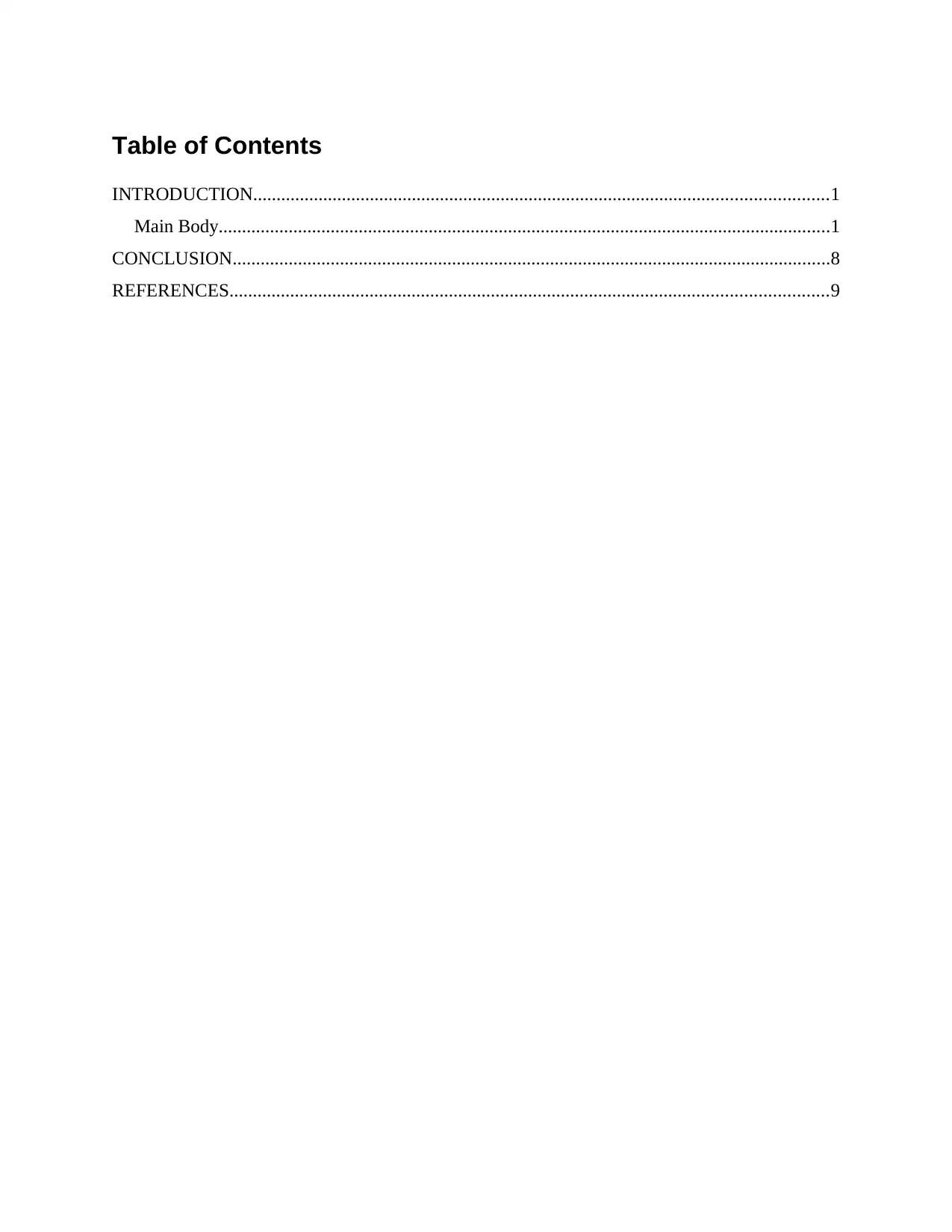
Table of Contents
INTRODUCTION...........................................................................................................................1
Main Body...................................................................................................................................1
CONCLUSION................................................................................................................................8
REFERENCES................................................................................................................................9
INTRODUCTION...........................................................................................................................1
Main Body...................................................................................................................................1
CONCLUSION................................................................................................................................8
REFERENCES................................................................................................................................9
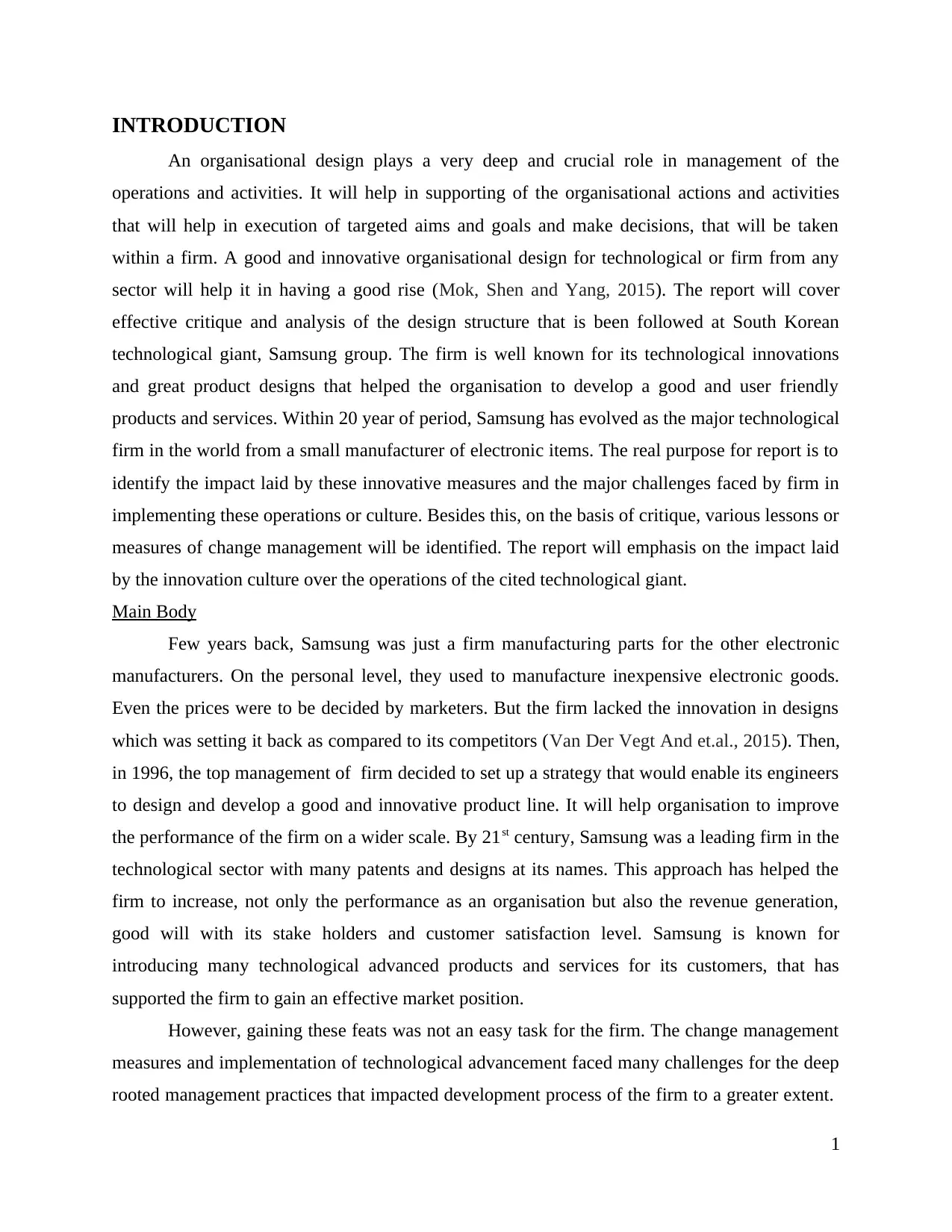
INTRODUCTION
An organisational design plays a very deep and crucial role in management of the
operations and activities. It will help in supporting of the organisational actions and activities
that will help in execution of targeted aims and goals and make decisions, that will be taken
within a firm. A good and innovative organisational design for technological or firm from any
sector will help it in having a good rise (Mok, Shen and Yang, 2015). The report will cover
effective critique and analysis of the design structure that is been followed at South Korean
technological giant, Samsung group. The firm is well known for its technological innovations
and great product designs that helped the organisation to develop a good and user friendly
products and services. Within 20 year of period, Samsung has evolved as the major technological
firm in the world from a small manufacturer of electronic items. The real purpose for report is to
identify the impact laid by these innovative measures and the major challenges faced by firm in
implementing these operations or culture. Besides this, on the basis of critique, various lessons or
measures of change management will be identified. The report will emphasis on the impact laid
by the innovation culture over the operations of the cited technological giant.
Main Body
Few years back, Samsung was just a firm manufacturing parts for the other electronic
manufacturers. On the personal level, they used to manufacture inexpensive electronic goods.
Even the prices were to be decided by marketers. But the firm lacked the innovation in designs
which was setting it back as compared to its competitors (Van Der Vegt And et.al., 2015). Then,
in 1996, the top management of firm decided to set up a strategy that would enable its engineers
to design and develop a good and innovative product line. It will help organisation to improve
the performance of the firm on a wider scale. By 21st century, Samsung was a leading firm in the
technological sector with many patents and designs at its names. This approach has helped the
firm to increase, not only the performance as an organisation but also the revenue generation,
good will with its stake holders and customer satisfaction level. Samsung is known for
introducing many technological advanced products and services for its customers, that has
supported the firm to gain an effective market position.
However, gaining these feats was not an easy task for the firm. The change management
measures and implementation of technological advancement faced many challenges for the deep
rooted management practices that impacted development process of the firm to a greater extent.
1
An organisational design plays a very deep and crucial role in management of the
operations and activities. It will help in supporting of the organisational actions and activities
that will help in execution of targeted aims and goals and make decisions, that will be taken
within a firm. A good and innovative organisational design for technological or firm from any
sector will help it in having a good rise (Mok, Shen and Yang, 2015). The report will cover
effective critique and analysis of the design structure that is been followed at South Korean
technological giant, Samsung group. The firm is well known for its technological innovations
and great product designs that helped the organisation to develop a good and user friendly
products and services. Within 20 year of period, Samsung has evolved as the major technological
firm in the world from a small manufacturer of electronic items. The real purpose for report is to
identify the impact laid by these innovative measures and the major challenges faced by firm in
implementing these operations or culture. Besides this, on the basis of critique, various lessons or
measures of change management will be identified. The report will emphasis on the impact laid
by the innovation culture over the operations of the cited technological giant.
Main Body
Few years back, Samsung was just a firm manufacturing parts for the other electronic
manufacturers. On the personal level, they used to manufacture inexpensive electronic goods.
Even the prices were to be decided by marketers. But the firm lacked the innovation in designs
which was setting it back as compared to its competitors (Van Der Vegt And et.al., 2015). Then,
in 1996, the top management of firm decided to set up a strategy that would enable its engineers
to design and develop a good and innovative product line. It will help organisation to improve
the performance of the firm on a wider scale. By 21st century, Samsung was a leading firm in the
technological sector with many patents and designs at its names. This approach has helped the
firm to increase, not only the performance as an organisation but also the revenue generation,
good will with its stake holders and customer satisfaction level. Samsung is known for
introducing many technological advanced products and services for its customers, that has
supported the firm to gain an effective market position.
However, gaining these feats was not an easy task for the firm. The change management
measures and implementation of technological advancement faced many challenges for the deep
rooted management practices that impacted development process of the firm to a greater extent.
1
Secure Best Marks with AI Grader
Need help grading? Try our AI Grader for instant feedback on your assignments.
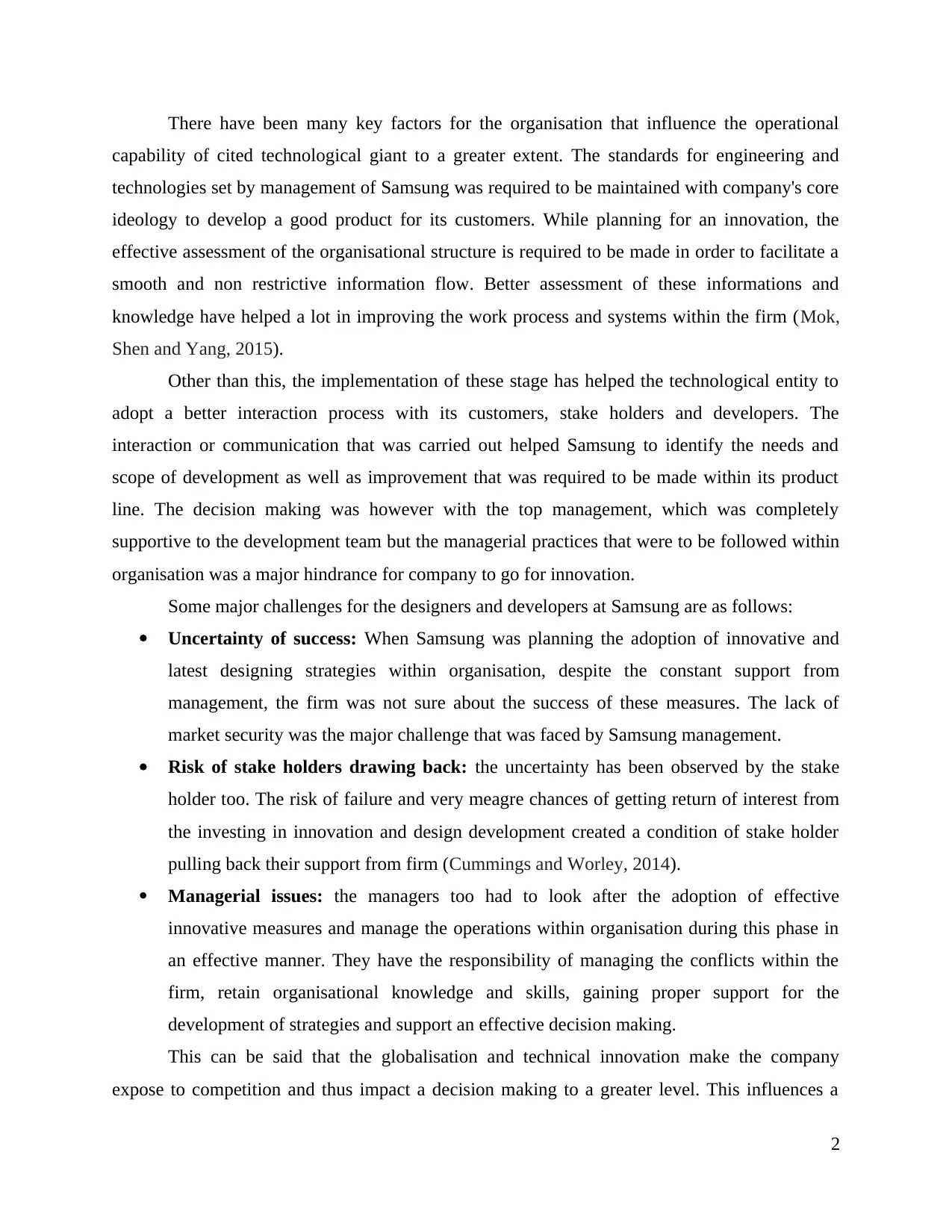
There have been many key factors for the organisation that influence the operational
capability of cited technological giant to a greater extent. The standards for engineering and
technologies set by management of Samsung was required to be maintained with company's core
ideology to develop a good product for its customers. While planning for an innovation, the
effective assessment of the organisational structure is required to be made in order to facilitate a
smooth and non restrictive information flow. Better assessment of these informations and
knowledge have helped a lot in improving the work process and systems within the firm (Mok,
Shen and Yang, 2015).
Other than this, the implementation of these stage has helped the technological entity to
adopt a better interaction process with its customers, stake holders and developers. The
interaction or communication that was carried out helped Samsung to identify the needs and
scope of development as well as improvement that was required to be made within its product
line. The decision making was however with the top management, which was completely
supportive to the development team but the managerial practices that were to be followed within
organisation was a major hindrance for company to go for innovation.
Some major challenges for the designers and developers at Samsung are as follows:
Uncertainty of success: When Samsung was planning the adoption of innovative and
latest designing strategies within organisation, despite the constant support from
management, the firm was not sure about the success of these measures. The lack of
market security was the major challenge that was faced by Samsung management.
Risk of stake holders drawing back: the uncertainty has been observed by the stake
holder too. The risk of failure and very meagre chances of getting return of interest from
the investing in innovation and design development created a condition of stake holder
pulling back their support from firm (Cummings and Worley, 2014).
Managerial issues: the managers too had to look after the adoption of effective
innovative measures and manage the operations within organisation during this phase in
an effective manner. They have the responsibility of managing the conflicts within the
firm, retain organisational knowledge and skills, gaining proper support for the
development of strategies and support an effective decision making.
This can be said that the globalisation and technical innovation make the company
expose to competition and thus impact a decision making to a greater level. This influences a
2
capability of cited technological giant to a greater extent. The standards for engineering and
technologies set by management of Samsung was required to be maintained with company's core
ideology to develop a good product for its customers. While planning for an innovation, the
effective assessment of the organisational structure is required to be made in order to facilitate a
smooth and non restrictive information flow. Better assessment of these informations and
knowledge have helped a lot in improving the work process and systems within the firm (Mok,
Shen and Yang, 2015).
Other than this, the implementation of these stage has helped the technological entity to
adopt a better interaction process with its customers, stake holders and developers. The
interaction or communication that was carried out helped Samsung to identify the needs and
scope of development as well as improvement that was required to be made within its product
line. The decision making was however with the top management, which was completely
supportive to the development team but the managerial practices that were to be followed within
organisation was a major hindrance for company to go for innovation.
Some major challenges for the designers and developers at Samsung are as follows:
Uncertainty of success: When Samsung was planning the adoption of innovative and
latest designing strategies within organisation, despite the constant support from
management, the firm was not sure about the success of these measures. The lack of
market security was the major challenge that was faced by Samsung management.
Risk of stake holders drawing back: the uncertainty has been observed by the stake
holder too. The risk of failure and very meagre chances of getting return of interest from
the investing in innovation and design development created a condition of stake holder
pulling back their support from firm (Cummings and Worley, 2014).
Managerial issues: the managers too had to look after the adoption of effective
innovative measures and manage the operations within organisation during this phase in
an effective manner. They have the responsibility of managing the conflicts within the
firm, retain organisational knowledge and skills, gaining proper support for the
development of strategies and support an effective decision making.
This can be said that the globalisation and technical innovation make the company
expose to competition and thus impact a decision making to a greater level. This influences a
2
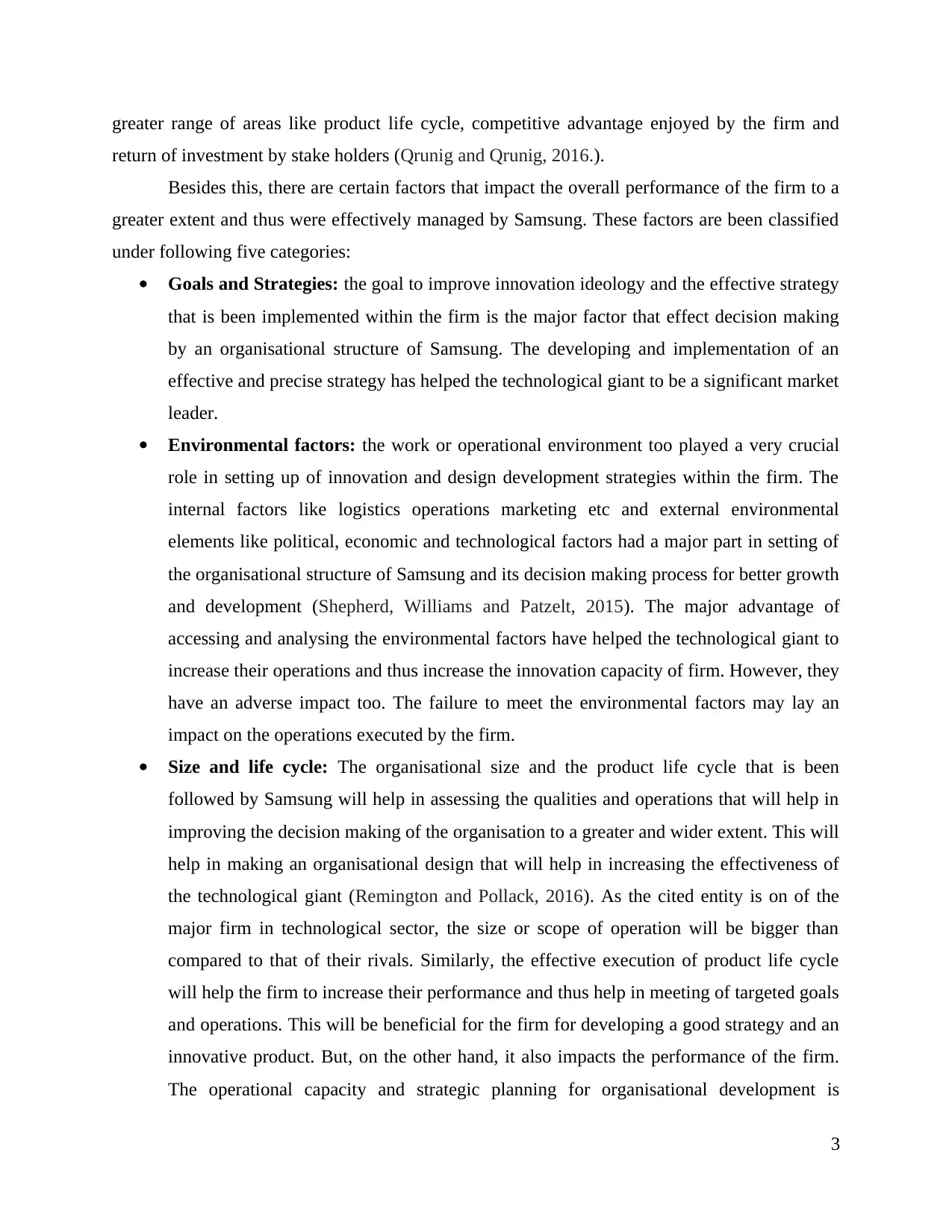
greater range of areas like product life cycle, competitive advantage enjoyed by the firm and
return of investment by stake holders (Qrunig and Qrunig, 2016.).
Besides this, there are certain factors that impact the overall performance of the firm to a
greater extent and thus were effectively managed by Samsung. These factors are been classified
under following five categories:
Goals and Strategies: the goal to improve innovation ideology and the effective strategy
that is been implemented within the firm is the major factor that effect decision making
by an organisational structure of Samsung. The developing and implementation of an
effective and precise strategy has helped the technological giant to be a significant market
leader.
Environmental factors: the work or operational environment too played a very crucial
role in setting up of innovation and design development strategies within the firm. The
internal factors like logistics operations marketing etc and external environmental
elements like political, economic and technological factors had a major part in setting of
the organisational structure of Samsung and its decision making process for better growth
and development (Shepherd, Williams and Patzelt, 2015). The major advantage of
accessing and analysing the environmental factors have helped the technological giant to
increase their operations and thus increase the innovation capacity of firm. However, they
have an adverse impact too. The failure to meet the environmental factors may lay an
impact on the operations executed by the firm.
Size and life cycle: The organisational size and the product life cycle that is been
followed by Samsung will help in assessing the qualities and operations that will help in
improving the decision making of the organisation to a greater and wider extent. This will
help in making an organisational design that will help in increasing the effectiveness of
the technological giant (Remington and Pollack, 2016). As the cited entity is on of the
major firm in technological sector, the size or scope of operation will be bigger than
compared to that of their rivals. Similarly, the effective execution of product life cycle
will help the firm to increase their performance and thus help in meeting of targeted goals
and operations. This will be beneficial for the firm for developing a good strategy and an
innovative product. But, on the other hand, it also impacts the performance of the firm.
The operational capacity and strategic planning for organisational development is
3
return of investment by stake holders (Qrunig and Qrunig, 2016.).
Besides this, there are certain factors that impact the overall performance of the firm to a
greater extent and thus were effectively managed by Samsung. These factors are been classified
under following five categories:
Goals and Strategies: the goal to improve innovation ideology and the effective strategy
that is been implemented within the firm is the major factor that effect decision making
by an organisational structure of Samsung. The developing and implementation of an
effective and precise strategy has helped the technological giant to be a significant market
leader.
Environmental factors: the work or operational environment too played a very crucial
role in setting up of innovation and design development strategies within the firm. The
internal factors like logistics operations marketing etc and external environmental
elements like political, economic and technological factors had a major part in setting of
the organisational structure of Samsung and its decision making process for better growth
and development (Shepherd, Williams and Patzelt, 2015). The major advantage of
accessing and analysing the environmental factors have helped the technological giant to
increase their operations and thus increase the innovation capacity of firm. However, they
have an adverse impact too. The failure to meet the environmental factors may lay an
impact on the operations executed by the firm.
Size and life cycle: The organisational size and the product life cycle that is been
followed by Samsung will help in assessing the qualities and operations that will help in
improving the decision making of the organisation to a greater and wider extent. This will
help in making an organisational design that will help in increasing the effectiveness of
the technological giant (Remington and Pollack, 2016). As the cited entity is on of the
major firm in technological sector, the size or scope of operation will be bigger than
compared to that of their rivals. Similarly, the effective execution of product life cycle
will help the firm to increase their performance and thus help in meeting of targeted goals
and operations. This will be beneficial for the firm for developing a good strategy and an
innovative product. But, on the other hand, it also impacts the performance of the firm.
The operational capacity and strategic planning for organisational development is
3
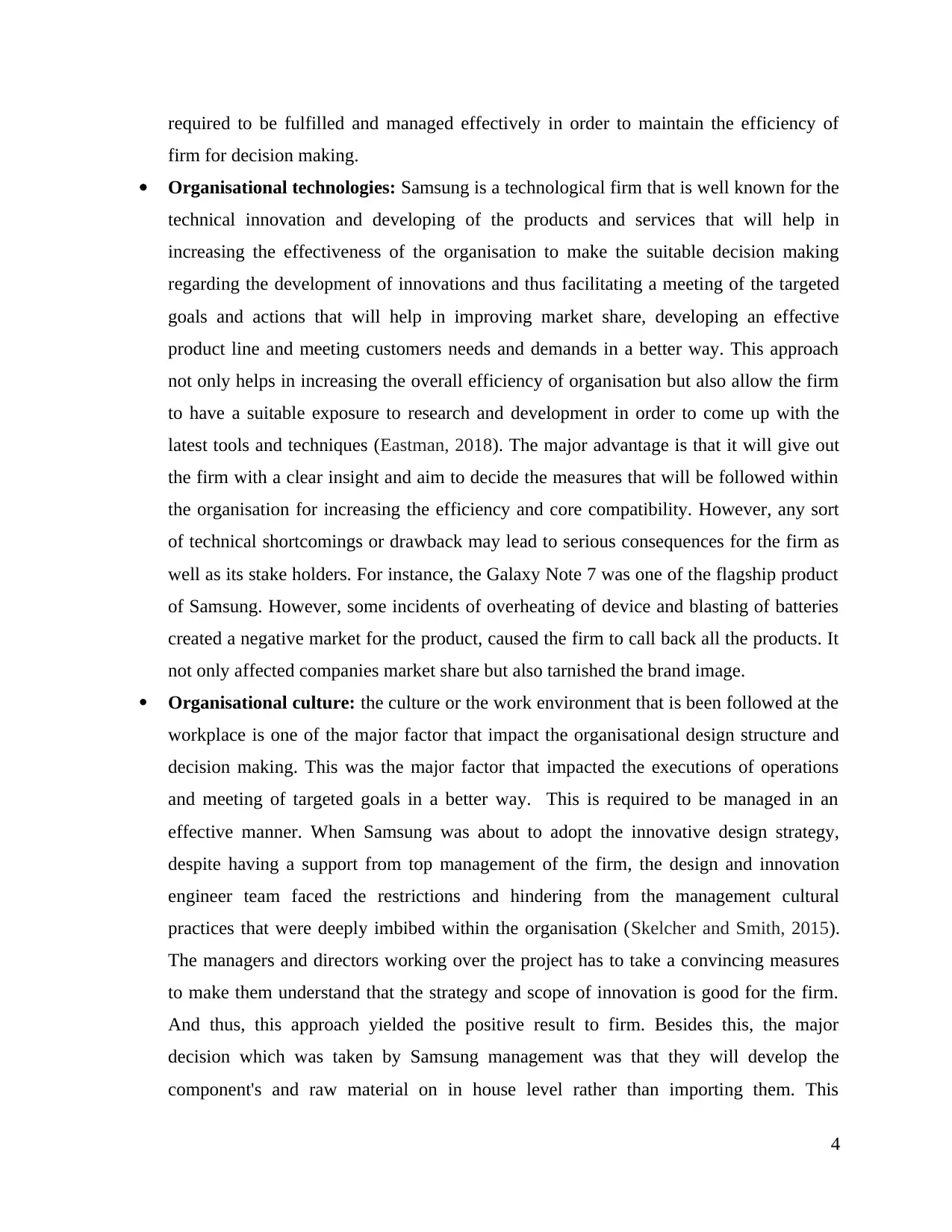
required to be fulfilled and managed effectively in order to maintain the efficiency of
firm for decision making.
Organisational technologies: Samsung is a technological firm that is well known for the
technical innovation and developing of the products and services that will help in
increasing the effectiveness of the organisation to make the suitable decision making
regarding the development of innovations and thus facilitating a meeting of the targeted
goals and actions that will help in improving market share, developing an effective
product line and meeting customers needs and demands in a better way. This approach
not only helps in increasing the overall efficiency of organisation but also allow the firm
to have a suitable exposure to research and development in order to come up with the
latest tools and techniques (Eastman, 2018). The major advantage is that it will give out
the firm with a clear insight and aim to decide the measures that will be followed within
the organisation for increasing the efficiency and core compatibility. However, any sort
of technical shortcomings or drawback may lead to serious consequences for the firm as
well as its stake holders. For instance, the Galaxy Note 7 was one of the flagship product
of Samsung. However, some incidents of overheating of device and blasting of batteries
created a negative market for the product, caused the firm to call back all the products. It
not only affected companies market share but also tarnished the brand image.
Organisational culture: the culture or the work environment that is been followed at the
workplace is one of the major factor that impact the organisational design structure and
decision making. This was the major factor that impacted the executions of operations
and meeting of targeted goals in a better way. This is required to be managed in an
effective manner. When Samsung was about to adopt the innovative design strategy,
despite having a support from top management of the firm, the design and innovation
engineer team faced the restrictions and hindering from the management cultural
practices that were deeply imbibed within the organisation (Skelcher and Smith, 2015).
The managers and directors working over the project has to take a convincing measures
to make them understand that the strategy and scope of innovation is good for the firm.
And thus, this approach yielded the positive result to firm. Besides this, the major
decision which was taken by Samsung management was that they will develop the
component's and raw material on in house level rather than importing them. This
4
firm for decision making.
Organisational technologies: Samsung is a technological firm that is well known for the
technical innovation and developing of the products and services that will help in
increasing the effectiveness of the organisation to make the suitable decision making
regarding the development of innovations and thus facilitating a meeting of the targeted
goals and actions that will help in improving market share, developing an effective
product line and meeting customers needs and demands in a better way. This approach
not only helps in increasing the overall efficiency of organisation but also allow the firm
to have a suitable exposure to research and development in order to come up with the
latest tools and techniques (Eastman, 2018). The major advantage is that it will give out
the firm with a clear insight and aim to decide the measures that will be followed within
the organisation for increasing the efficiency and core compatibility. However, any sort
of technical shortcomings or drawback may lead to serious consequences for the firm as
well as its stake holders. For instance, the Galaxy Note 7 was one of the flagship product
of Samsung. However, some incidents of overheating of device and blasting of batteries
created a negative market for the product, caused the firm to call back all the products. It
not only affected companies market share but also tarnished the brand image.
Organisational culture: the culture or the work environment that is been followed at the
workplace is one of the major factor that impact the organisational design structure and
decision making. This was the major factor that impacted the executions of operations
and meeting of targeted goals in a better way. This is required to be managed in an
effective manner. When Samsung was about to adopt the innovative design strategy,
despite having a support from top management of the firm, the design and innovation
engineer team faced the restrictions and hindering from the management cultural
practices that were deeply imbibed within the organisation (Skelcher and Smith, 2015).
The managers and directors working over the project has to take a convincing measures
to make them understand that the strategy and scope of innovation is good for the firm.
And thus, this approach yielded the positive result to firm. Besides this, the major
decision which was taken by Samsung management was that they will develop the
component's and raw material on in house level rather than importing them. This
4
Paraphrase This Document
Need a fresh take? Get an instant paraphrase of this document with our AI Paraphraser
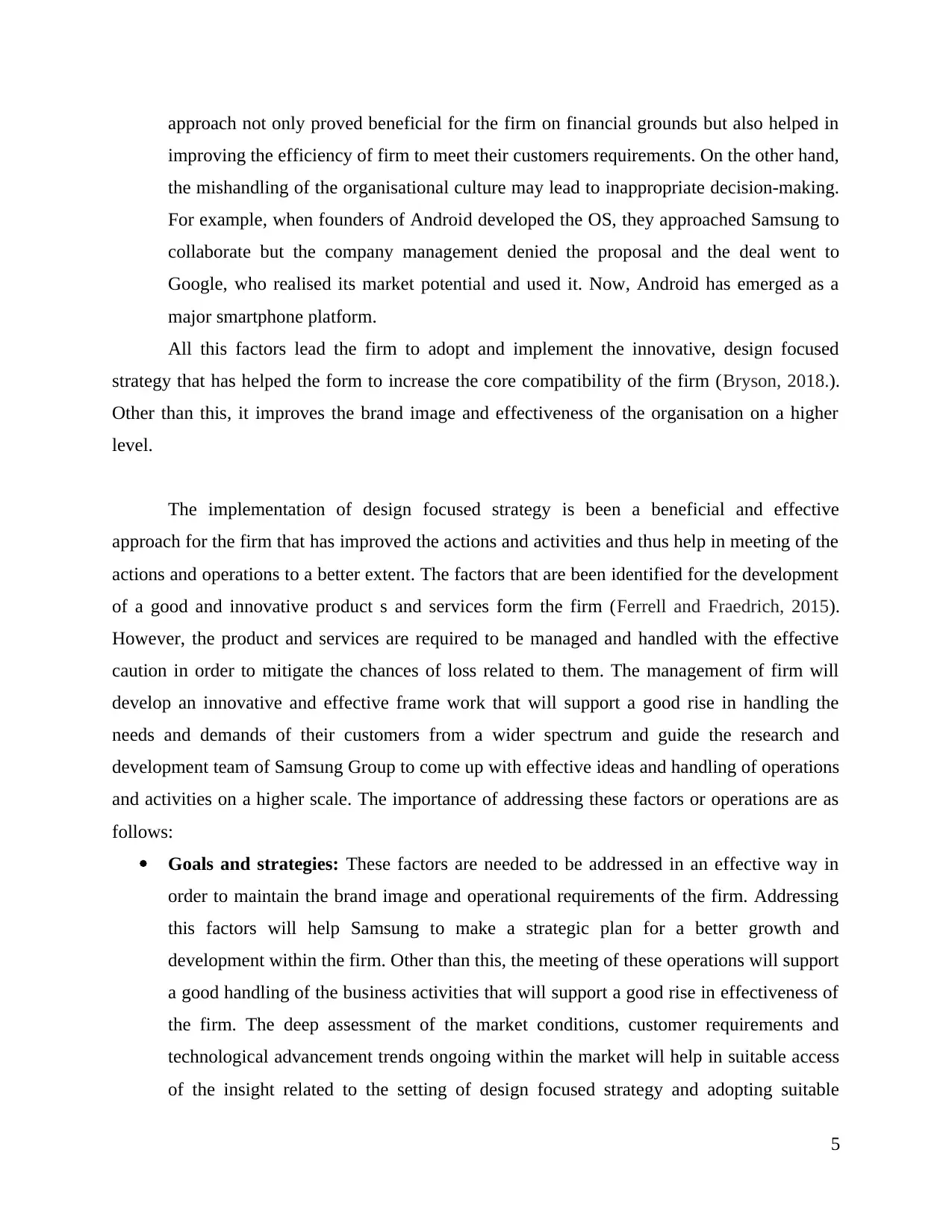
approach not only proved beneficial for the firm on financial grounds but also helped in
improving the efficiency of firm to meet their customers requirements. On the other hand,
the mishandling of the organisational culture may lead to inappropriate decision-making.
For example, when founders of Android developed the OS, they approached Samsung to
collaborate but the company management denied the proposal and the deal went to
Google, who realised its market potential and used it. Now, Android has emerged as a
major smartphone platform.
All this factors lead the firm to adopt and implement the innovative, design focused
strategy that has helped the form to increase the core compatibility of the firm (Bryson, 2018.).
Other than this, it improves the brand image and effectiveness of the organisation on a higher
level.
The implementation of design focused strategy is been a beneficial and effective
approach for the firm that has improved the actions and activities and thus help in meeting of the
actions and operations to a better extent. The factors that are been identified for the development
of a good and innovative product s and services form the firm (Ferrell and Fraedrich, 2015).
However, the product and services are required to be managed and handled with the effective
caution in order to mitigate the chances of loss related to them. The management of firm will
develop an innovative and effective frame work that will support a good rise in handling the
needs and demands of their customers from a wider spectrum and guide the research and
development team of Samsung Group to come up with effective ideas and handling of operations
and activities on a higher scale. The importance of addressing these factors or operations are as
follows:
Goals and strategies: These factors are needed to be addressed in an effective way in
order to maintain the brand image and operational requirements of the firm. Addressing
this factors will help Samsung to make a strategic plan for a better growth and
development within the firm. Other than this, the meeting of these operations will support
a good handling of the business activities that will support a good rise in effectiveness of
the firm. The deep assessment of the market conditions, customer requirements and
technological advancement trends ongoing within the market will help in suitable access
of the insight related to the setting of design focused strategy and adopting suitable
5
improving the efficiency of firm to meet their customers requirements. On the other hand,
the mishandling of the organisational culture may lead to inappropriate decision-making.
For example, when founders of Android developed the OS, they approached Samsung to
collaborate but the company management denied the proposal and the deal went to
Google, who realised its market potential and used it. Now, Android has emerged as a
major smartphone platform.
All this factors lead the firm to adopt and implement the innovative, design focused
strategy that has helped the form to increase the core compatibility of the firm (Bryson, 2018.).
Other than this, it improves the brand image and effectiveness of the organisation on a higher
level.
The implementation of design focused strategy is been a beneficial and effective
approach for the firm that has improved the actions and activities and thus help in meeting of the
actions and operations to a better extent. The factors that are been identified for the development
of a good and innovative product s and services form the firm (Ferrell and Fraedrich, 2015).
However, the product and services are required to be managed and handled with the effective
caution in order to mitigate the chances of loss related to them. The management of firm will
develop an innovative and effective frame work that will support a good rise in handling the
needs and demands of their customers from a wider spectrum and guide the research and
development team of Samsung Group to come up with effective ideas and handling of operations
and activities on a higher scale. The importance of addressing these factors or operations are as
follows:
Goals and strategies: These factors are needed to be addressed in an effective way in
order to maintain the brand image and operational requirements of the firm. Addressing
this factors will help Samsung to make a strategic plan for a better growth and
development within the firm. Other than this, the meeting of these operations will support
a good handling of the business activities that will support a good rise in effectiveness of
the firm. The deep assessment of the market conditions, customer requirements and
technological advancement trends ongoing within the market will help in suitable access
of the insight related to the setting of design focused strategy and adopting suitable
5
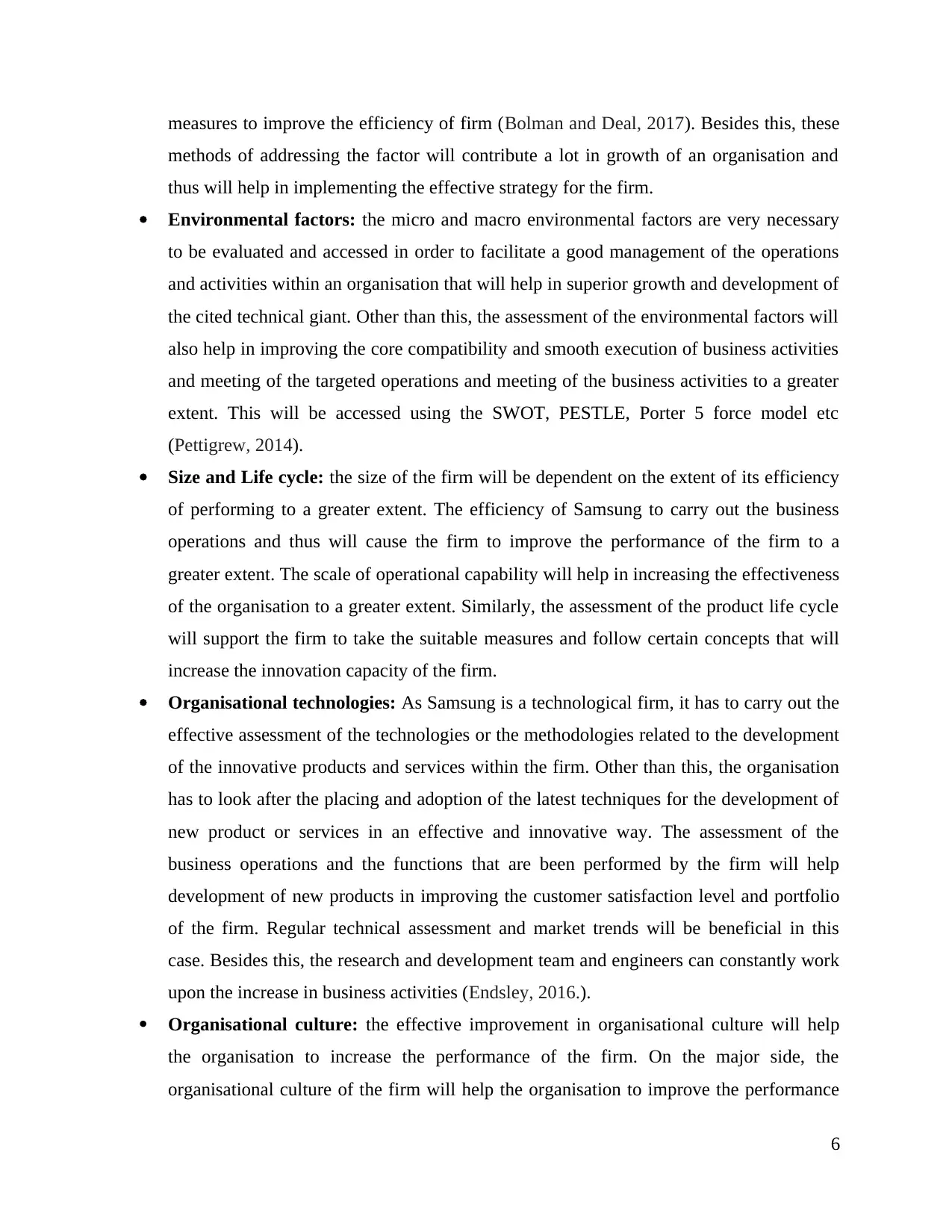
measures to improve the efficiency of firm (Bolman and Deal, 2017). Besides this, these
methods of addressing the factor will contribute a lot in growth of an organisation and
thus will help in implementing the effective strategy for the firm.
Environmental factors: the micro and macro environmental factors are very necessary
to be evaluated and accessed in order to facilitate a good management of the operations
and activities within an organisation that will help in superior growth and development of
the cited technical giant. Other than this, the assessment of the environmental factors will
also help in improving the core compatibility and smooth execution of business activities
and meeting of the targeted operations and meeting of the business activities to a greater
extent. This will be accessed using the SWOT, PESTLE, Porter 5 force model etc
(Pettigrew, 2014).
Size and Life cycle: the size of the firm will be dependent on the extent of its efficiency
of performing to a greater extent. The efficiency of Samsung to carry out the business
operations and thus will cause the firm to improve the performance of the firm to a
greater extent. The scale of operational capability will help in increasing the effectiveness
of the organisation to a greater extent. Similarly, the assessment of the product life cycle
will support the firm to take the suitable measures and follow certain concepts that will
increase the innovation capacity of the firm.
Organisational technologies: As Samsung is a technological firm, it has to carry out the
effective assessment of the technologies or the methodologies related to the development
of the innovative products and services within the firm. Other than this, the organisation
has to look after the placing and adoption of the latest techniques for the development of
new product or services in an effective and innovative way. The assessment of the
business operations and the functions that are been performed by the firm will help
development of new products in improving the customer satisfaction level and portfolio
of the firm. Regular technical assessment and market trends will be beneficial in this
case. Besides this, the research and development team and engineers can constantly work
upon the increase in business activities (Endsley, 2016.).
Organisational culture: the effective improvement in organisational culture will help
the organisation to increase the performance of the firm. On the major side, the
organisational culture of the firm will help the organisation to improve the performance
6
methods of addressing the factor will contribute a lot in growth of an organisation and
thus will help in implementing the effective strategy for the firm.
Environmental factors: the micro and macro environmental factors are very necessary
to be evaluated and accessed in order to facilitate a good management of the operations
and activities within an organisation that will help in superior growth and development of
the cited technical giant. Other than this, the assessment of the environmental factors will
also help in improving the core compatibility and smooth execution of business activities
and meeting of the targeted operations and meeting of the business activities to a greater
extent. This will be accessed using the SWOT, PESTLE, Porter 5 force model etc
(Pettigrew, 2014).
Size and Life cycle: the size of the firm will be dependent on the extent of its efficiency
of performing to a greater extent. The efficiency of Samsung to carry out the business
operations and thus will cause the firm to improve the performance of the firm to a
greater extent. The scale of operational capability will help in increasing the effectiveness
of the organisation to a greater extent. Similarly, the assessment of the product life cycle
will support the firm to take the suitable measures and follow certain concepts that will
increase the innovation capacity of the firm.
Organisational technologies: As Samsung is a technological firm, it has to carry out the
effective assessment of the technologies or the methodologies related to the development
of the innovative products and services within the firm. Other than this, the organisation
has to look after the placing and adoption of the latest techniques for the development of
new product or services in an effective and innovative way. The assessment of the
business operations and the functions that are been performed by the firm will help
development of new products in improving the customer satisfaction level and portfolio
of the firm. Regular technical assessment and market trends will be beneficial in this
case. Besides this, the research and development team and engineers can constantly work
upon the increase in business activities (Endsley, 2016.).
Organisational culture: the effective improvement in organisational culture will help
the organisation to increase the performance of the firm. On the major side, the
organisational culture of the firm will help the organisation to improve the performance
6
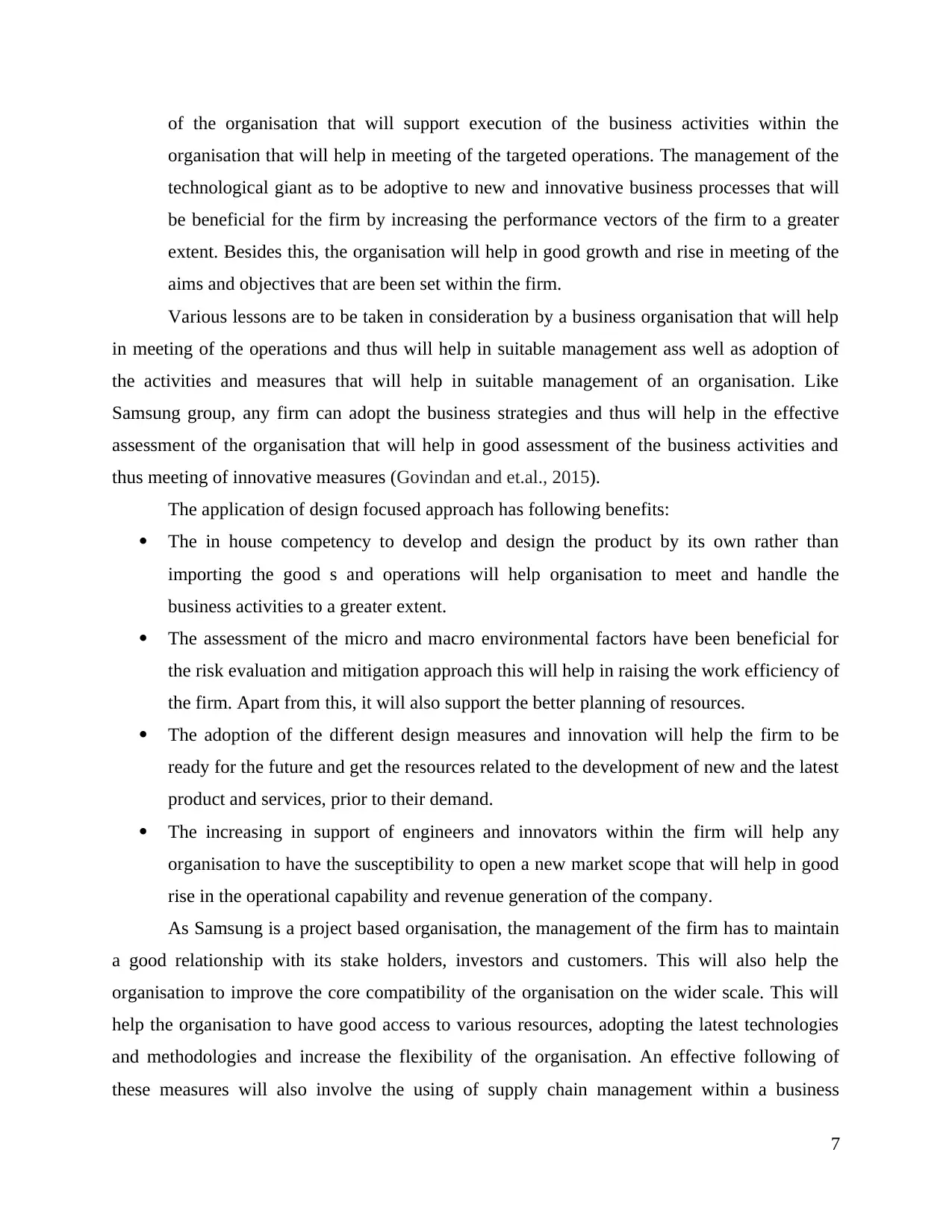
of the organisation that will support execution of the business activities within the
organisation that will help in meeting of the targeted operations. The management of the
technological giant as to be adoptive to new and innovative business processes that will
be beneficial for the firm by increasing the performance vectors of the firm to a greater
extent. Besides this, the organisation will help in good growth and rise in meeting of the
aims and objectives that are been set within the firm.
Various lessons are to be taken in consideration by a business organisation that will help
in meeting of the operations and thus will help in suitable management ass well as adoption of
the activities and measures that will help in suitable management of an organisation. Like
Samsung group, any firm can adopt the business strategies and thus will help in the effective
assessment of the organisation that will help in good assessment of the business activities and
thus meeting of innovative measures (Govindan and et.al., 2015).
The application of design focused approach has following benefits:
The in house competency to develop and design the product by its own rather than
importing the good s and operations will help organisation to meet and handle the
business activities to a greater extent.
The assessment of the micro and macro environmental factors have been beneficial for
the risk evaluation and mitigation approach this will help in raising the work efficiency of
the firm. Apart from this, it will also support the better planning of resources.
The adoption of the different design measures and innovation will help the firm to be
ready for the future and get the resources related to the development of new and the latest
product and services, prior to their demand.
The increasing in support of engineers and innovators within the firm will help any
organisation to have the susceptibility to open a new market scope that will help in good
rise in the operational capability and revenue generation of the company.
As Samsung is a project based organisation, the management of the firm has to maintain
a good relationship with its stake holders, investors and customers. This will also help the
organisation to improve the core compatibility of the organisation on the wider scale. This will
help the organisation to have good access to various resources, adopting the latest technologies
and methodologies and increase the flexibility of the organisation. An effective following of
these measures will also involve the using of supply chain management within a business
7
organisation that will help in meeting of the targeted operations. The management of the
technological giant as to be adoptive to new and innovative business processes that will
be beneficial for the firm by increasing the performance vectors of the firm to a greater
extent. Besides this, the organisation will help in good growth and rise in meeting of the
aims and objectives that are been set within the firm.
Various lessons are to be taken in consideration by a business organisation that will help
in meeting of the operations and thus will help in suitable management ass well as adoption of
the activities and measures that will help in suitable management of an organisation. Like
Samsung group, any firm can adopt the business strategies and thus will help in the effective
assessment of the organisation that will help in good assessment of the business activities and
thus meeting of innovative measures (Govindan and et.al., 2015).
The application of design focused approach has following benefits:
The in house competency to develop and design the product by its own rather than
importing the good s and operations will help organisation to meet and handle the
business activities to a greater extent.
The assessment of the micro and macro environmental factors have been beneficial for
the risk evaluation and mitigation approach this will help in raising the work efficiency of
the firm. Apart from this, it will also support the better planning of resources.
The adoption of the different design measures and innovation will help the firm to be
ready for the future and get the resources related to the development of new and the latest
product and services, prior to their demand.
The increasing in support of engineers and innovators within the firm will help any
organisation to have the susceptibility to open a new market scope that will help in good
rise in the operational capability and revenue generation of the company.
As Samsung is a project based organisation, the management of the firm has to maintain
a good relationship with its stake holders, investors and customers. This will also help the
organisation to improve the core compatibility of the organisation on the wider scale. This will
help the organisation to have good access to various resources, adopting the latest technologies
and methodologies and increase the flexibility of the organisation. An effective following of
these measures will also involve the using of supply chain management within a business
7
Secure Best Marks with AI Grader
Need help grading? Try our AI Grader for instant feedback on your assignments.
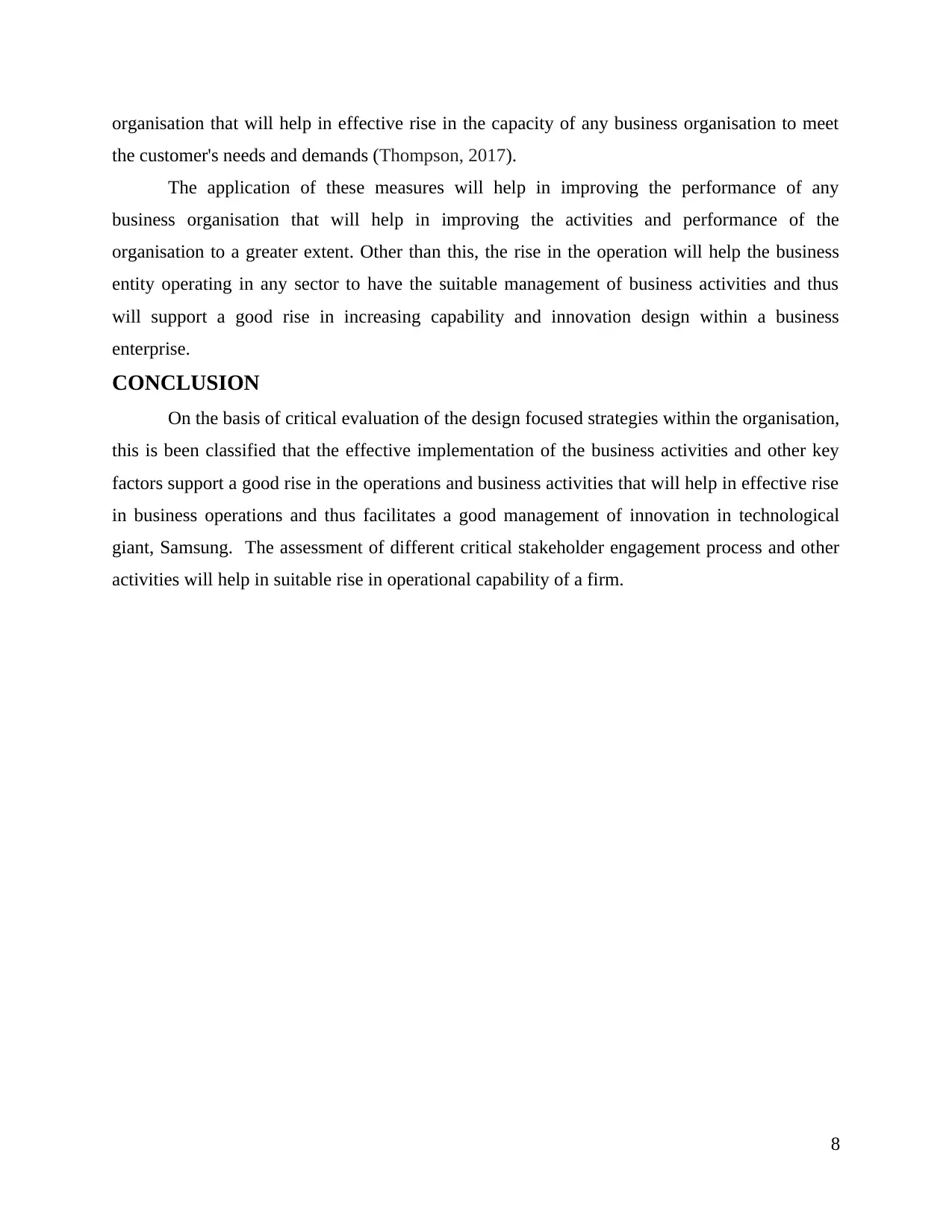
organisation that will help in effective rise in the capacity of any business organisation to meet
the customer's needs and demands (Thompson, 2017).
The application of these measures will help in improving the performance of any
business organisation that will help in improving the activities and performance of the
organisation to a greater extent. Other than this, the rise in the operation will help the business
entity operating in any sector to have the suitable management of business activities and thus
will support a good rise in increasing capability and innovation design within a business
enterprise.
CONCLUSION
On the basis of critical evaluation of the design focused strategies within the organisation,
this is been classified that the effective implementation of the business activities and other key
factors support a good rise in the operations and business activities that will help in effective rise
in business operations and thus facilitates a good management of innovation in technological
giant, Samsung. The assessment of different critical stakeholder engagement process and other
activities will help in suitable rise in operational capability of a firm.
8
the customer's needs and demands (Thompson, 2017).
The application of these measures will help in improving the performance of any
business organisation that will help in improving the activities and performance of the
organisation to a greater extent. Other than this, the rise in the operation will help the business
entity operating in any sector to have the suitable management of business activities and thus
will support a good rise in increasing capability and innovation design within a business
enterprise.
CONCLUSION
On the basis of critical evaluation of the design focused strategies within the organisation,
this is been classified that the effective implementation of the business activities and other key
factors support a good rise in the operations and business activities that will help in effective rise
in business operations and thus facilitates a good management of innovation in technological
giant, Samsung. The assessment of different critical stakeholder engagement process and other
activities will help in suitable rise in operational capability of a firm.
8
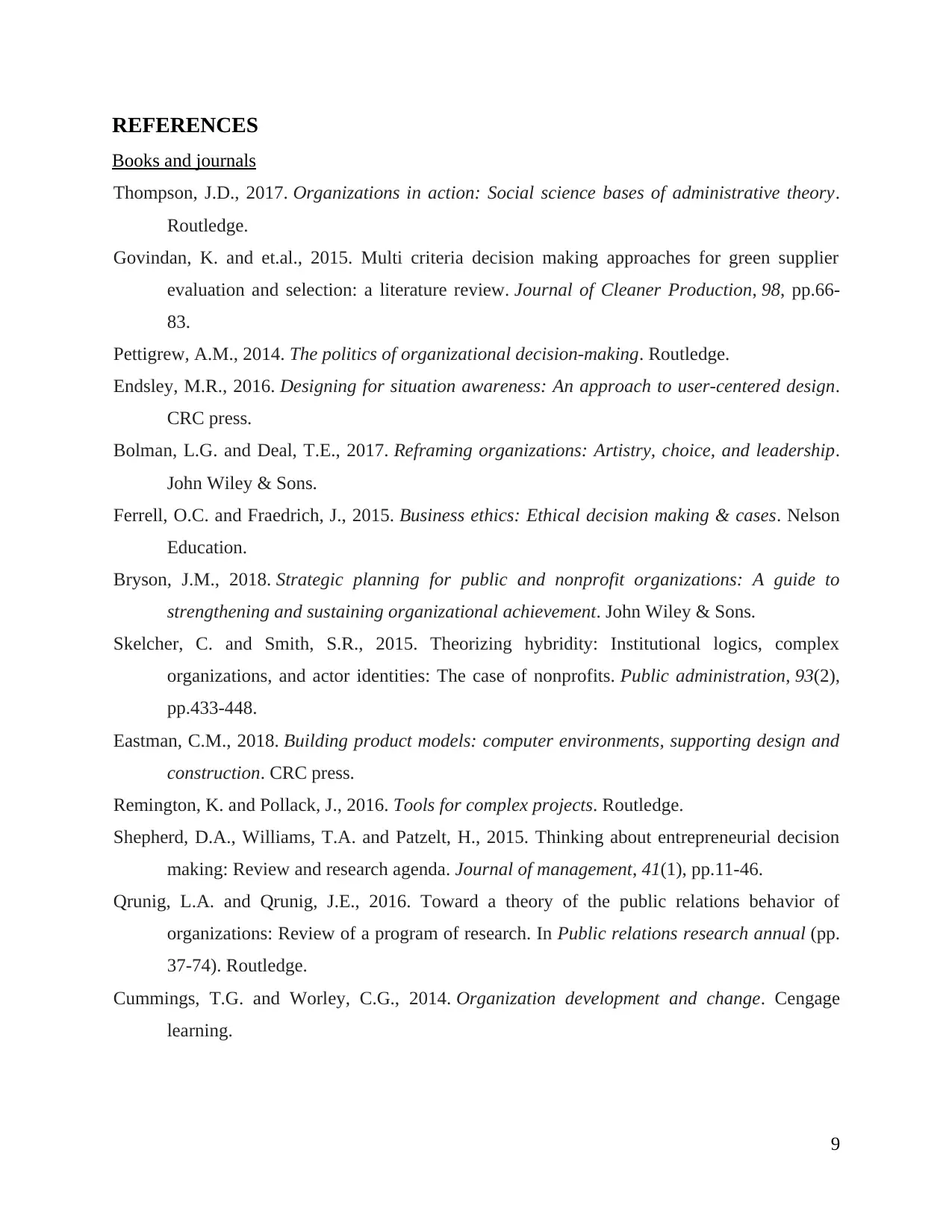
REFERENCES
Books and journals
Thompson, J.D., 2017. Organizations in action: Social science bases of administrative theory.
Routledge.
Govindan, K. and et.al., 2015. Multi criteria decision making approaches for green supplier
evaluation and selection: a literature review. Journal of Cleaner Production, 98, pp.66-
83.
Pettigrew, A.M., 2014. The politics of organizational decision-making. Routledge.
Endsley, M.R., 2016. Designing for situation awareness: An approach to user-centered design.
CRC press.
Bolman, L.G. and Deal, T.E., 2017. Reframing organizations: Artistry, choice, and leadership.
John Wiley & Sons.
Ferrell, O.C. and Fraedrich, J., 2015. Business ethics: Ethical decision making & cases. Nelson
Education.
Bryson, J.M., 2018. Strategic planning for public and nonprofit organizations: A guide to
strengthening and sustaining organizational achievement. John Wiley & Sons.
Skelcher, C. and Smith, S.R., 2015. Theorizing hybridity: Institutional logics, complex
organizations, and actor identities: The case of nonprofits. Public administration, 93(2),
pp.433-448.
Eastman, C.M., 2018. Building product models: computer environments, supporting design and
construction. CRC press.
Remington, K. and Pollack, J., 2016. Tools for complex projects. Routledge.
Shepherd, D.A., Williams, T.A. and Patzelt, H., 2015. Thinking about entrepreneurial decision
making: Review and research agenda. Journal of management, 41(1), pp.11-46.
Qrunig, L.A. and Qrunig, J.E., 2016. Toward a theory of the public relations behavior of
organizations: Review of a program of research. In Public relations research annual (pp.
37-74). Routledge.
Cummings, T.G. and Worley, C.G., 2014. Organization development and change. Cengage
learning.
9
Books and journals
Thompson, J.D., 2017. Organizations in action: Social science bases of administrative theory.
Routledge.
Govindan, K. and et.al., 2015. Multi criteria decision making approaches for green supplier
evaluation and selection: a literature review. Journal of Cleaner Production, 98, pp.66-
83.
Pettigrew, A.M., 2014. The politics of organizational decision-making. Routledge.
Endsley, M.R., 2016. Designing for situation awareness: An approach to user-centered design.
CRC press.
Bolman, L.G. and Deal, T.E., 2017. Reframing organizations: Artistry, choice, and leadership.
John Wiley & Sons.
Ferrell, O.C. and Fraedrich, J., 2015. Business ethics: Ethical decision making & cases. Nelson
Education.
Bryson, J.M., 2018. Strategic planning for public and nonprofit organizations: A guide to
strengthening and sustaining organizational achievement. John Wiley & Sons.
Skelcher, C. and Smith, S.R., 2015. Theorizing hybridity: Institutional logics, complex
organizations, and actor identities: The case of nonprofits. Public administration, 93(2),
pp.433-448.
Eastman, C.M., 2018. Building product models: computer environments, supporting design and
construction. CRC press.
Remington, K. and Pollack, J., 2016. Tools for complex projects. Routledge.
Shepherd, D.A., Williams, T.A. and Patzelt, H., 2015. Thinking about entrepreneurial decision
making: Review and research agenda. Journal of management, 41(1), pp.11-46.
Qrunig, L.A. and Qrunig, J.E., 2016. Toward a theory of the public relations behavior of
organizations: Review of a program of research. In Public relations research annual (pp.
37-74). Routledge.
Cummings, T.G. and Worley, C.G., 2014. Organization development and change. Cengage
learning.
9
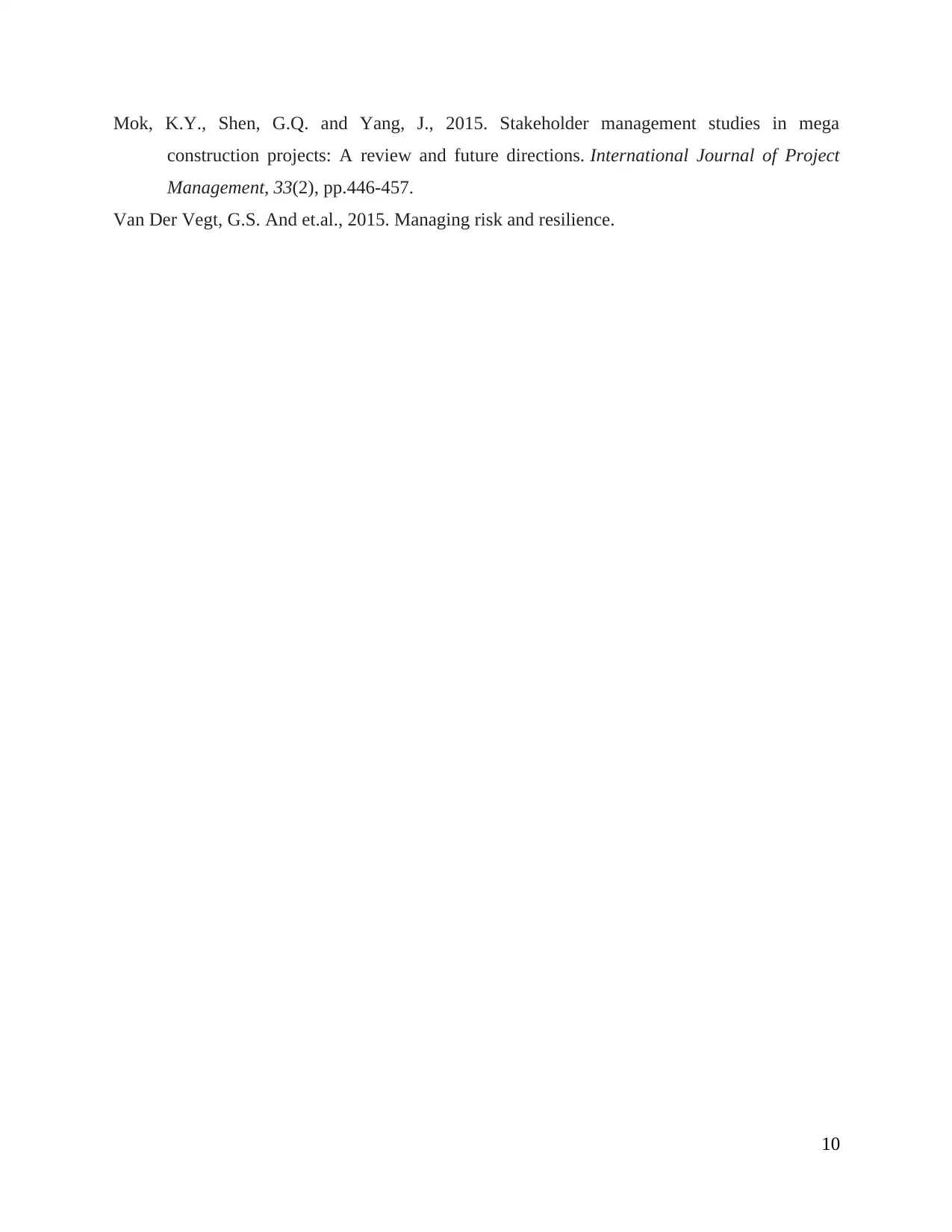
Mok, K.Y., Shen, G.Q. and Yang, J., 2015. Stakeholder management studies in mega
construction projects: A review and future directions. International Journal of Project
Management, 33(2), pp.446-457.
Van Der Vegt, G.S. And et.al., 2015. Managing risk and resilience.
10
construction projects: A review and future directions. International Journal of Project
Management, 33(2), pp.446-457.
Van Der Vegt, G.S. And et.al., 2015. Managing risk and resilience.
10
1 out of 13
Related Documents
Your All-in-One AI-Powered Toolkit for Academic Success.
+13062052269
info@desklib.com
Available 24*7 on WhatsApp / Email
![[object Object]](/_next/static/media/star-bottom.7253800d.svg)
Unlock your academic potential
© 2024 | Zucol Services PVT LTD | All rights reserved.





